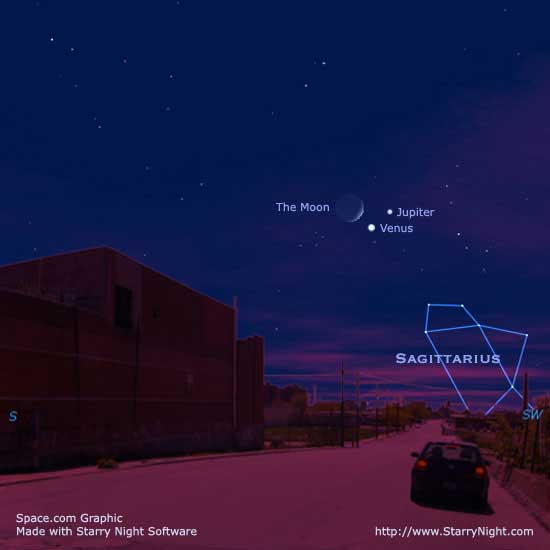
The most spectacular celestial sight during these final days of November is reserved for the early evening sky, as Jupiter and Venus, the two brightest planets, draw closer together.
The waxing crescent moon will join the planets on the first evening of December for a striking celestial trio.
One of my astronomy mentors, Dr. Kenneth L. Franklin (1923-2007), a former Chairman and Chief Astronomer at New York's Hayden Planetarium, often made reference to our "dynamic and ever-changing night sky." Such an eloquent description certainly fits our current evening sky, as we now have a celestial summit meeting in the making in the western evening twilight.
For the remainder of November, evening skywatchers can watch as each evening Jupiter and Venus slowly converge on each other in the southwestern sky, right after sunset. The two planets will appear a similar distance apart on both the evenings of Nov. 30 and Dec. 1. They will be so close you'll be able to stretch your arm out and, with your thumb, blot both of them out.
After Dec. 1, like two celestial ships passing in the night, the planets will slowly separate, but there will still be one more eye-catching sight to see. For on that very same evening, those who gaze toward the south-southwest sky for up to about two hours after sunset arise will be treated to a spectacular sight as Venus, Jupiter and the crescent moon cluster closely together. The trio will form a wide isosceles triangle, with Venus at the vertex.
It should prove quite a spectacle for naked eye, binoculars, or camera. Imagine the astrological significance that the ancients might have ascribed to a celestial summit meeting such as this! Moreover, for much of Europe, the moon will actually appear to cross in front of Venus resulting in a rare occultation.
Writing of this spectacular celestial configuration in Guy Ottewell's 2008 Astronomical Calendar, Fred Schaaf calls the sight "stunning," adding that "they will draw all eyes their way."
Get the Space.com Newsletter
Breaking space news, the latest updates on rocket launches, skywatching events and more!
The moment of closest approach for Venus and Jupiter will actually come during the early morning hours of Dec. 1, unfortunately when this "dynamic duo" is below the horizon for North America. They'll be separated by just over 2-degrees, which correspond to roughly one-half the distance that separates Pollux from Castor, the "Twin Stars" of Gemini (The width of your fist, held at arm's length roughly corresponds to 10-degrees).
Generally speaking, at least for the next few years, conjunctions between Venus and Jupiter come in pairs. The first conjunction takes place in the morning sky, usually followed about 10 months later by another in the evening sky. Then, two and a half years later, Venus and Jupiter are again in conjunction, again in the morning sky. On Feb. 1 of this year, Venus and Jupiter were paired-off in the morning sky. After Dec. 1, Venus and Jupiter will next get together again in the morning sky on May 11, 2011. And ten months later, in March of 2012 they will again pair off in the evening sky right after sundown.
Joe Rao serves as an instructor and guest lecturer at New York's Hayden Planetarium. He writes about astronomy for The New York Times and other publications, and he is also an on-camera meteorologist for News 12 Westchester, New York.
Join our Space Forums to keep talking space on the latest missions, night sky and more! And if you have a news tip, correction or comment, let us know at: community@space.com.

Joe Rao is Space.com's skywatching columnist, as well as a veteran meteorologist and eclipse chaser who also serves as an instructor and guest lecturer at New York's Hayden Planetarium. He writes about astronomy for Natural History magazine, Sky & Telescope and other publications. Joe is an 8-time Emmy-nominated meteorologist who served the Putnam Valley region of New York for over 21 years. You can find him on Twitter and YouTube tracking lunar and solar eclipses, meteor showers and more. To find out Joe's latest project, visit him on Twitter.









